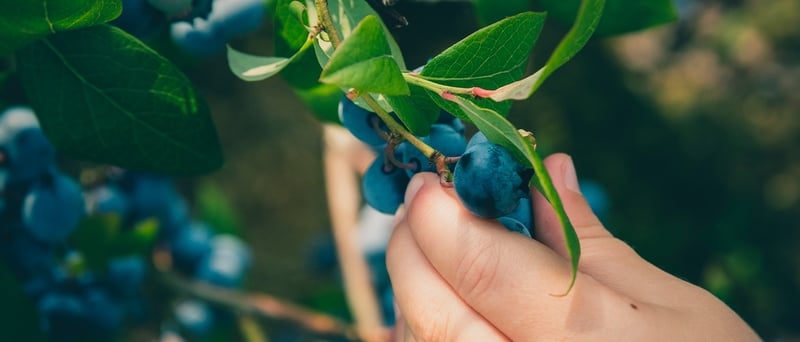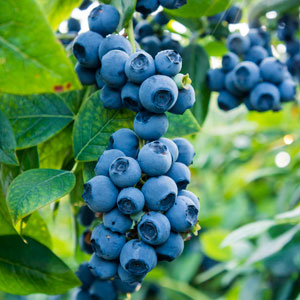Blueberry Growing Guide
About Blueberries
Dainty, distinctive and downright delicious, blueberries are prized by gourmet cooks and nutrition buffs alike. High in antioxidants, they’re one of very few naturally occurring foods that are truly blue in colour. The berries grow on perennial shrubs that are great landscape additions in their own right, with bright red foliage in autumn and attractive flowers in spring.
Once established, they can give fruit for up to twenty years. What more could you ask for?
Taxonomy
Genus Vaccinium in the family Ericaceae. This genus includes other plants with edible berries, such as cranberries, huckleberries and lingonberries.
The Ericaceae family is also home to rhododendrons, including azaleas.
How To Grow Blueberries
Climatic Zones
Blueberry plants generally do best in cool, temperate and arid zones in Australia, with most varieties requiring a winter frost in order to set fruit. See individual product details for ideal growing regions.
When To Plant Blueberries
Blueberries are best planted between late autumn and spring.

Where To Plant Blueberries
Choose a position with full sun. At least 4-6 hours of sunlight (preferably afternoon sun) is necessary for good fruit ripening.
Soil Preparation
Soil needs to be well-drained and rich in organic matter. The ideal soil for blueberries is acidic, with a pH of 4.5 to 5.5.
You can check your soil pH with a home testing kit. If you have azaleas or camellias that are doing well, it’s likely that your blueberries will be happy alongside them, as they have similar tastes in soil.

If these types of plants don’t grow well in your area, it’s a safe bet that blueberries will struggle unless you can adapt your soil to their needs.
To lower soil pH, dig through a mix of organic matter, peat, pine needles, and aluminium sulphate or sulphur. Please be aware that all of these different products have different reactive times, with some having an immediate effect and others taking more time to work their magic.
Alternatively, you can dig in a good quality potting mix designed for azaleas and camellias.
Whichever method you use, you’ll need to monitor the soil on an ongoing basis to make sure the pH stays within the right range.
How To Plant Blueberries
Dig the planting hole twice the size of the pot, adding compost as a booster, and water in well.
Planting a few different varieties will mean your plants crop at different times, resulting in a longer harvest period. In some cases, this can also assist with pollination.
When planting in containers, go for a fairly large pot and use a premium potting mix for azaleas and camellias.
Blueberry Plant Care
Plants generally begin fruiting at around two years. After two to three years, pruning is needed to ensure a good yield year after year. The overall aim here is to create an open, vase-shaped plant. It’s also good to remove any spindly, dead-looking branches in late winter or early spring. Removing flowers from the developing plants for the first few seasons can assist plants in establishing.
Regular, deep watering is essential for a good fruit crop. Note that blueberries can’t tolerate waterlogged soil, however.
For potted plants, mulch over the warm season to help keep the fine root system cool, and fertilise every 3-4 months with a slow-release fertiliser for azaleas and camellias. In spring, top dress the soil with fresh potting mix, and repot as needed as the plant grows larger.
Harvesting Fruit
Growing blueberries to eat means keeping the birds off them. This typically requires constructing a frame over your blueberry patch and covering it with bird netting. It’s important to use netting designed to keep out birds only, as bees still need to get in to pollinate the plants.

Blueberries will not ripen after being picked. Give them at least a week after they have fully darkened to sweeten up, and taste test a few berries to make sure they’re ready before harvesting. Be careful not to damage any shoots on the branches, as this is where next year’s crop will come from.
Blueberries freeze exceptionally well, and this is the best way of preserving the fruit’s nutritional goodness – especially if you have a lot of them!
Recommended Varieties
For planting in Autumn, we recommend Blueberry Sunshine Blue, a dwarf bush that produces masses of large, sweet berries in late spring and summer. As well as being self-fertile, this variety is frost tolerant but does not require a cold winter to produce fruit. This makes it suitable for all parts of Australia. Compared to other varieties, it’s also more tolerant of a higher soil pH, so it’s one of the less tricky blueberries to grow.
Give blueberries a go, and be rewarded with delicious and nutritious results!









